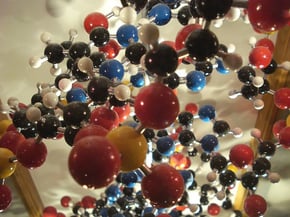 Protein quantitation or estimation assays are widely used for determining protein concentration and are considered to be one of the most widely used methods in life science research. Estimation of protein concentration is necessary in protein purification, electrophoresis, cell biology, molecular biology, and other research applications.
Protein quantitation or estimation assays are widely used for determining protein concentration and are considered to be one of the most widely used methods in life science research. Estimation of protein concentration is necessary in protein purification, electrophoresis, cell biology, molecular biology, and other research applications.
Since proteins are complex amino acids polymers that have numerous structural modifications and variations, they require different chemical agents to make them stable for analysis. However, the presence of non-protein buffers and reagents (such as detergents, chaotropes, salts and reducing agents) which are used in the preparation of protein samples may cause band distortion and poor protein resolution.
Protein solutions containing surfactants (detergents) interfere with the dye based protein assays while those containing reducing agents, metal chelating agents, dyes, amines, and sugars cannot be estimated with the protein assays based on copper ions. This makes SDS-PAGE gels difficult to analyze and leads to low reproducibility. Thus, protein researchers should be capable of removing non-protein agents from the protein solutions and/or be able to choose the methods that circumvent the interfering effects of non-protein agents present in the protein samples.
The Effects of Interfering Agents on Protein Estimation Assays
Detergents
While detergents help solubilize and stabilize proteins, disaggregate protein complexes, and aid in protein folding, they need to be removed before proceeding to the subsequent steps since they may cause precipitation, especially when used in the modified Lowry protein assay. The presence of detergents in modified Bradford assays can also lead to deleterious effects since they may shift the pH and/or affect the linearity of the response once the proteins precipitate.
To solve the problem, you may dilute your sample or dialyze it to reduce the concentration of the detergent to the point where it no longer interferes. However, since detergents with low CMCs and large aggregation numbers cannot be dialyzed, ion exchange chromatography and/or sucrose density gradient separation can be used to remove this interfering agent from the protein solution.
Reducing agents
The presence of reducing agents such as dithiothreitol (DTT), ß-mercaptoethanol and TCEP at concentrations routinely used in protein sample buffers can interfere with the modified Lowry and BCA protein assays. To remove these interfering substances from your precious protein sample, consider adding acetone or trichloroacetic acid (TCA) to precipitate the proteins in the sample and separate them from the interfering agents.
Chaotropes
Chaotropic agents are often used to disrupt the hydrogen bonding network between macromolecules (such as proteins) in a solution, and destroy their three-dimensional structure. Chaotropes are often used in conjunction with detergents to facilitate the denaturation and emulsification of the biological system, and to reduce the possibility of protein aggregation.
Some of the most common chaotropic agents used in protein estimation assays include urea, guanidine hydrochloride, guanidine isothiocyanate and sodium iodide. Please note that the presence of some chaotropic agents such as guanidine HCl can have a detrimental effect prior to electrophoresis since they may trigger protein precipitation upon mixing with sample loading buffers.
In addition, copper chelating agents, strong acids and bases, ammonium salts, nucleic acid, lipid droplets, and particulates may also interfere with the results of your protein estimation experiments. To avoid these problems from taking place, you need to remove these non-protein agents from the protein solution and/or be able to choose the most appropriate method to evade the interfering affects of these non-protein agents.
How do you do this? There are several options available. You can either use Non-Interfering™ (NI™) Protein Assays, CB-X™, SPN™ and SPN™ to remove non-protein agents from the protein solutions, or use RED 660™ and Bicinchoninic Acid (BCA) Reducing Agent Compatible Protein Assay to increase your assay's resistance to detergents and reducing agents, respectively. You can also use the dotMETRIC™ protein assay to circumvent the interfering effects of non-protein agents in the protein solution.
Image source: Duncan Hull






